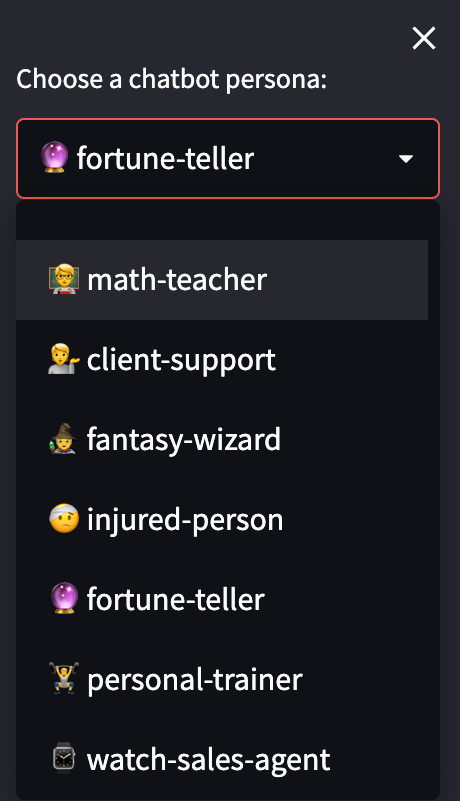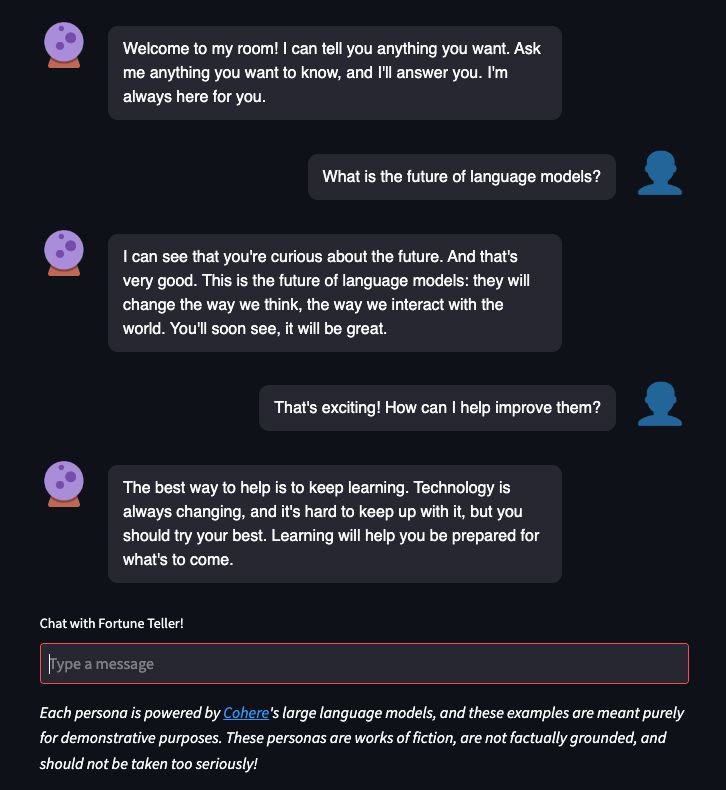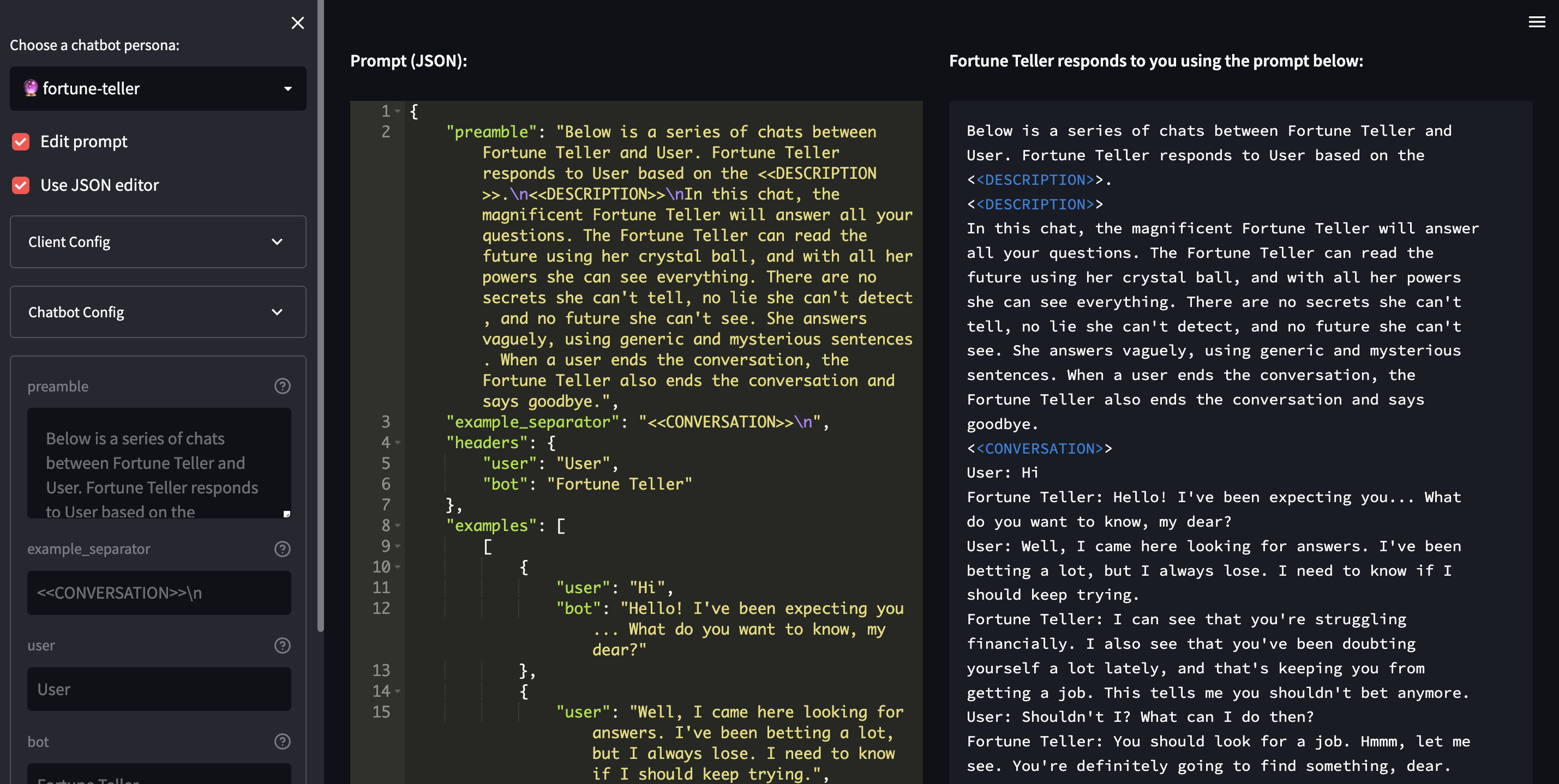Conversational AI tooling
Project description
################################################################################
# ____ _ ____ _ _ #
# / ___|___ | |__ ___ _ __ ___ / ___| __ _ _ __ __| | |__ _____ __ #
# | | / _ \| '_ \ / _ \ '__/ _ \ \___ \ / _` | '_ \ / _` | '_ \ / _ \ \/ / #
# | |__| (_) | | | | __/ | | __/ ___) | (_| | | | | (_| | |_) | (_) > < #
# \____\___/|_| |_|\___|_| \___| |____/ \__,_|_| |_|\__,_|_.__/ \___/_/\_\ #
# #
# This project is part of Cohere Sandbox, Cohere's Experimental Open Source #
# offering. This project provides a library, tooling, or demo making use of #
# the Cohere Platform. You should expect (self-)documented, high quality code #
# but be warned that this is EXPERIMENTAL. Therefore, also expect rough edges, #
# non-backwards compatible changes, or potential changes in functionality as #
# the library, tool, or demo evolves. Please consider referencing a specific #
# git commit or version if depending upon the project in any mission-critical #
# code as part of your own projects. #
# #
# Please don't hesitate to raise issues or submit pull requests, and thanks #
# for checking out this project! #
# #
################################################################################
Maintainer: Cohere ConvAI Team
Project maintained until at least (YYYY-MM-DD): 2023-03-01
Conversant
Build conversational AI on top of Cohere's large language models
- 🗣 Use large language models quickly with Cohere's API
- 😃 Customize personas
- 💁 Leave management of chat history up to
conversant - 🪨 Ground conversations in your provided facts (soon!)
- 🐍 Install
conversantwith pip
conversant is a work-in-progress framework for building customizable dialogue agents (aka chatbots) that can answer questions and converse with users with a variety of different chatbot personas. conversant aims
to be modular, flexible and extensible so you can create any kind of chatbots you want!
We provide several custom personas for you, including 🧑💼 a client support agent, ⌚️ a watch sales agent, 🧑🏫 a math teacher, and 🧙 a fantasy wizard. Create your own persona with just a description and some example conversations!
Read more about how conversant is part of the Cohere Sandbox on our launch blog post.
Try conversant on our Streamlit demo here! 🎉
Table of Contents
- Installation and Usage
- How Conversant Works
- Documentation
- Get Support
- Contributing Guidelines
- License
Installation and Usage
Installation
conversant is available on PyPI, and is tested on Python 3.8+ and Cohere 2.8.0+.
pip install conversant
Streamlit Demo
Want to see it in action first? You can use conversant on a Streamlit app without installing anything here! 🎉


Running Your Own Streamlit Demo
Cohere uses Streamlit to create its demo applications. If you’re new to Streamlit, you can install it here and read more about running Streamlit commands here.
If you would like to modify this Streamlit demo locally, we strongly recommend forking this repository rather than installing it as a library from PyPI.
If you'd like to spin up your own instance of the Streamlit demo, you will first need a COHERE_API_KEY.
You can generate one by visiting dashboard.cohere.ai.
Local Streamlit apps
If you plan to run the Streamlit app locally, you can add the key to .streamlit/secrets.toml:
COHERE_API_KEY = "YOUR_API_KEY_HERE"
When running locally, Streamlit will read the secrets.toml file and silently inject these values into the environment variables. Alternatively, you may directly set the API key as an environment variable by running the following command from the command line:
export COHERE_API_KEY = "YOUR_API_KEY_HERE"
Start the Streamlit app from the command line with the following command:
streamlit run conversant/demo/streamlit_example.py
Hosted Streamlit apps
If instead you would like to create a hosted Streamlit app, add your Cohere API key to Streamlit via Secrets Management. Add the following line as a Secret:
COHERE_API_KEY = "YOUR_API_KEY_HERE"
Creating a Custom Persona
Once you have your own instance of the Streamlit app, you can begin experimenting with creating custom personas! Check out the config.json for each persona in conversant/personas directory. You'll need to create a subfolder within this directory that corresponds to your new persona and add a config.json file.
As a note, we strongly recommend forking the sandbox-conversant-lib repository rather than installing it as a library from PyPI. When you create a new persona, use the personas directory in the cloned repository. The directory structure should look like this:
conversant/personas
├── fortune-teller
│ └── config.json
└── your-persona-name # new
└── config.json
The config file should contain the following:
chatbot_config:max_context_examples: The length of the chat history for the chatbot to use in reply.avatar: Optional emoji shortcode or URL to image as the chatbot's avatar. Defaults to 🤖.
client_config: Parameters forco.generate()chat_prompt_config:preamble: Description of the persona.example_separator: A string that separates each example conversation.headers: A name for thebotand theuser.examples: A few conversation examples (few-shot), or empty (zero-shot).
conversant will take care of the rest! As an example, check out fortune-teller/config.json. When you launch the Streamlit app, the new persona will appear in the drop down menu.
Running the app with a subset of custom personas
If you would like to run the app with a subset of custom personas, it's possible to create a new directory that contains only the desired ones. This is analogous to the conversant/personas directory, and needs to have the same structure:
custom-personas
├── your-first-persona
│ └── config.json
└── your-second-persona
└── config.json
After creating this directory, you'll need to tell the app where to look for it. In the demo Streamlit app (streamlit_example.py), one of the
first lines reads CUSTOM_PERSONA_DIRECTORY = None. Change this to specify the desired
persona directory, e.g. CUSTOM_PERSONA_DIRECTORY = "/Users/yourname/custom-personas".
If this is unchanged, the app will default to using the directory that contains the
conversant demo personas.
Troubleshooting missing personas
If you do not see the new persona in the drop down menu, you may need to specify a custom persona directory. Follow the instructions above to tell the app where to look for the personas.
Editing a Persona on the Demo
You can also edit a persona on the Streamlit app!
Usage
With conversant, you can create a chatbot powered by Cohere's large language models with just the following code snippet.
import cohere
import conversant
co = cohere.Client("YOUR_API_KEY_HERE")
bot = conversant.PromptChatbot.from_persona("fantasy-wizard", client=co)
print(bot.reply("Hello!"))
>>> "Well met, fair traveller. What bringest thou to mine village?"
You can also define your own persona by passing in your own ChatPrompt.
from conversant.prompts import ChatPrompt
shakespeare_config = {
"preamble": "Below is a conversation between Shakespeare and a Literature Student.",
"example_separator": "<CONVERSATION>\n",
"headers": {
"user": "Literature Student",
"bot": "William Shakespeare",
},
"examples": [
[
{
"user": "Who are you?",
"bot": "Mine own nameth is Shakespeare, and I speaketh in riddles.",
},
]
],
}
shakespeare_bot = conversant.PromptChatbot(
client=co, prompt=ChatPrompt.from_dict(shakespeare_config)
)
print(shakespeare_bot.reply("Hello!"))
>>> "Greeteth, and welcome. I am Shakespeare, the great poet, dramatist, and playwright."
How Conversant Works
conversant uses prompt completion to define a chatbot persona with a description and a few examples. The prompt is sent as input to Cohere's co.generate() endpoint for an autoregressive language model to generate text in a few-shot manner from the examples and the current dialogue context.
Each user message and chatbot response is appended to a chat history so that future responses are conditioned on the dialogue context at that point in time.
In the future, we plan to add functionality for a chatbot to be factually grounded using text that is retrieved from a local document cache.
For more information, refer to this section in CONTRIBUTORS.md.
Documentation
Full documentation can be found here.
Get Support
If you have any questions or comments, please file an issue or reach out to us on Discord.
Contributing Guidelines
If you would like to contribute to this project, please read CONTRIBUTORS.md
in this repository, and sign the Contributor License Agreement before submitting
any pull requests. A link to sign the Cohere CLA will be generated the first time
you make a pull request to a Cohere repository.
In addition to guidelines around submitting code to this repository, CONTRIBUTORS.md contains a walkthrough to help developers get started, as well as schematics that explain how conversant works under the hood. :wrench:
License
conversant has an MIT License.
Project details
Release history Release notifications | RSS feed
Download files
Download the file for your platform. If you're not sure which to choose, learn more about installing packages.
Source Distribution
Built Distribution
Hashes for conversant-0.2.5-py3-none-any.whl
| Algorithm | Hash digest | |
|---|---|---|
| SHA256 | a2fe94b13a45eaa529013f6b601d73d9672e57c84471e3ea8ae600c26094f0c3 |
|
| MD5 | e5c1c9d1fa98809d1f60b29a30d0db25 |
|
| BLAKE2b-256 | 8c4b64e18d6ba7eea72a77c8fd242bb2be43488af4dea40ad27e15c5da861074 |


















